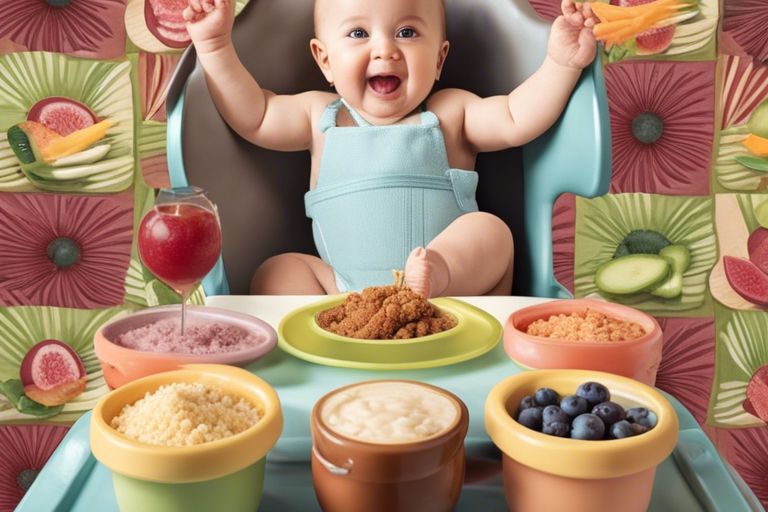tips, tricks and guides for parenthood
With your little one growing up quickly, it's time to navigate their transition to textured foods. Introducing solid foods is a major milestone in your baby's development, but it can also be a bit challenging. Choking hazards and allergies are important factors to consider as you expand their culinary horizons. However, this stage is also an exciting opportunity to explore new flavours and stimulate their senses. In this blog post, we will guide you through this crucial phase, providing tips and tricks to make the journey to textured foods as smooth and enjoyable as possible.

Clearly, before introducing textured foods to your baby, it's crucial to look out for signs that indicate they are ready. These signs may include good head control, ability to sit with support, showing interest in what you are eating, and making chewing motions.
Any parent may wonder about the right age to start their baby on textured foods. It is recommended to introduce textured foods around 6 to 9 months of age, when your baby has started to develop their chewing skills and can handle lumpier food.
It's important to note that every baby is different, and some may be ready earlier or later than others. You can also look for cues like reaching for food, trying to grab the spoon, or showing curiosity about different textures on their plate.
Some parents may feel a bit overwhelmed when it's time for their baby to transition from smooth purees to more textured foods. But don't worry, with the right approach and preparation, you can make this milestone exciting and stress-free for both you and your little one.
For a smooth transition to textured foods, you'll need a few key kitchen tools. Invest in a good quality hand blender or food processor to help you puree and mash different foods to the desired consistency. A set of small, soft-tipped spoons and forks will come in handy for feeding your baby and introducing them to self-feeding. Lastly, make sure you have a variety of small bowls and plates for serving different textured foods.
An important aspect of transitioning to textured foods is choosing safe and healthy options for your baby. When introducing new textures, remember to start with soft foods that are easy to swallow and digest. Opt for cooked vegetables, soft fruits, and well-cooked grains as initial choices. Avoiding foods that are potential choking hazards, such as whole grapes, nuts, and hard candies, is crucial during this phase.
For
To transition your baby from smooth purees to semi-solids, gradually introduce thicker textures and chunkier foods. Start by mixing purees with small amounts of mashed fruits or vegetables to help your baby get used to the new texture. Pay attention to your baby's cues and progress at a pace that is comfortable for them.
common concerns such as gagging can be nerve-wracking for parents, but it's important to remember that gagging is a normal part of learning to eat solid foods. Handling it calmly and knowing when to intervene is crucial. If your baby is gagging, resist the urge to panic and give them a chance to self-regulate. Knowing the difference between gagging and choking is important for a parent's confidence in this process.
Keep your little one's taste buds excited by introducing new flavours and combinations as you progress to more textured foods. Offer a variety of fruits, vegetables, grains, and proteins to expand their palate and provide crucial nutrients. You can try mixing different ingredients together to create interesting and tasty combinations that will keep mealtime fun and engaging.
Introducing a variety of textures is crucial for establishing a balanced diet for your baby. Start by offering soft and mashed foods, then gradually introduce more challenging textures like small soft pieces or finger foods. Make sure to include a good mix of carbohydrates, proteins, healthy fats, vitamins, and minerals in their meals to support their growth and development.
With these considerations in mind, navigating your baby's transition to textured foods can be an exciting and rewarding experience. By following your baby's cues, being patient, offering a variety of nutritious options, and ensuring a safe eating environment, you can help your little one develop healthy eating habits that will last a lifetime. Remember to enjoy this journey together, celebrating each new milestone as your baby explores and enjoys the world of solid foods.
A: Transitioning to textured foods is crucial for your baby's development as it helps them learn to chew, strengthen their jaw muscles, and promotes speech development.
A: You can start introducing textured foods to your baby around 6 to 9 months of age, when they show signs of being ready such as sitting up unassisted and showing interest in food.
A: Start by offering mashed or finely chopped soft foods like bananas, avocados, or cooked vegetables. Slowly increase the texture as your baby gets more comfortable with chewing.
A: Signs that your baby is ready for textured foods include reaching out for your food, trying to chew on their toys, showing an interest in what you are eating, and being able to sit up without support.
A: Avoid hard foods, small foods that could be a choking hazard, and foods high in salt or sugar. Be cautious with nut butters and whole nuts until your baby is older. Always supervise your baby during meal times.